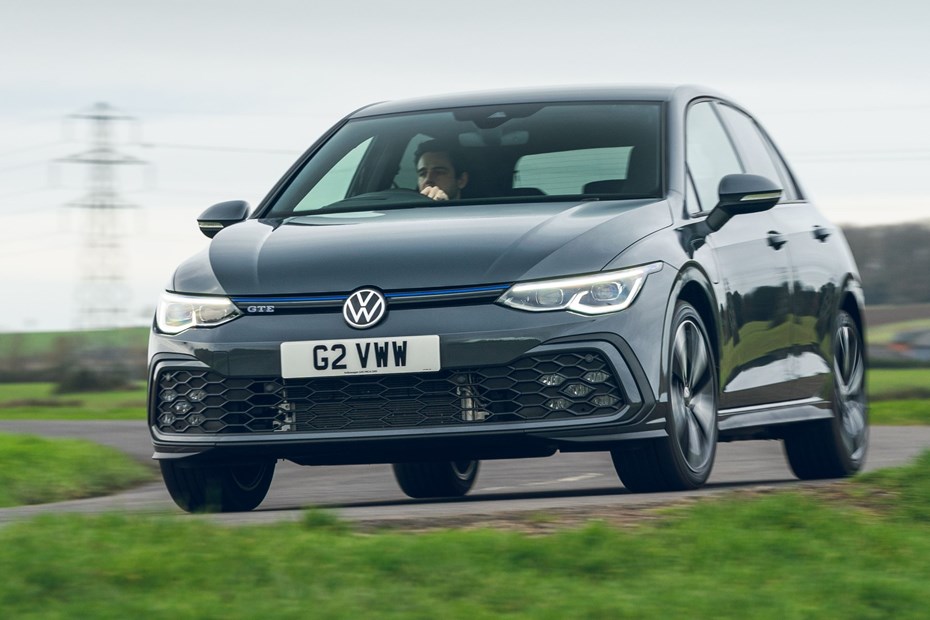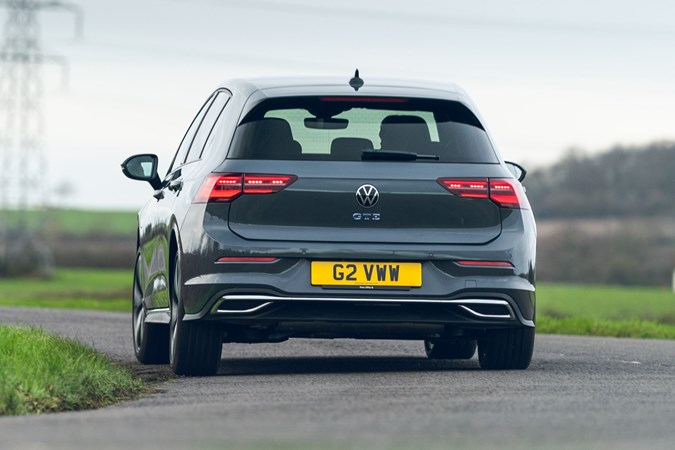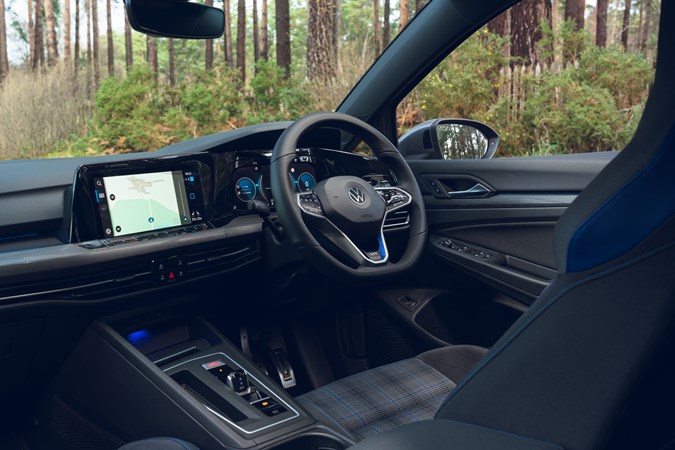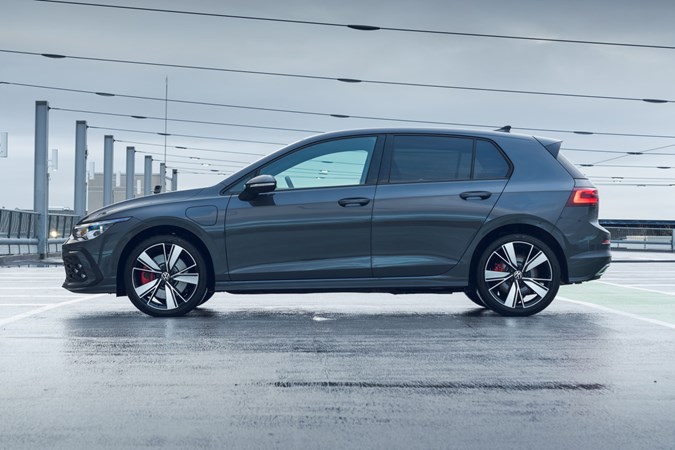
Volkswagen Golf GTE review

At a glance
| Price new | £40,140 |
|---|---|
| Used prices | £15,782 - £28,471 |
| Road tax cost | £195 - £620 |
| Insurance group | 27 - 30 |
Get an insurance quote with

|
|
| Fuel economy | 45.6 mpg |
| Miles per pound | 6.7 |
| Number of doors | 5 |
| View full specs for a specific version | |
Available fuel types
Hybrid
Pros & cons
- Usable electric range
- Genuinely quick
- Practical hatchback body
- Cheap as a company car
- Infuriating infotainment
- Too heavy to be very fun
- Mechanically similar siblings are cheaper
- Doesn’t feel as premium as previous model
Overview
This is the second version of the Golf GTE – a plug-in hybrid hot hatchback, something that’s likely to become more and more familiar in years to come.
Based on the eighth-generation Golf (the GTE line was introduced with the Golf 7 in 2015) the GTE aims to tick just about every box, with the pace of a performance car but running costs to shame even the most miserly diesel. And it wraps it all up in a familiar, practical hatchback package.
With plug-in hybrids offering incredible value as a company car, we’re likely to see more and more rivals to the Golf appear. In fact, two already have. The Cupra Leon e-Hybrid and Skoda Octavia iV vRS are the Golf GTE’s sister cars – using nearly identical mechanicals but different bodywork.

And for those who don’t necessarily need the performance angle, there are a whole host of plug-in rivals already on the market – from the classy Mercedes-Benz A250e to the SUV-shaped Mini Countryman S E.
That’s not to forget non-hybrid rivals, either, particularly other versions of the Golf such as the well-regarded GTI and GTD.
So to succeed, Volkswagen needs to do what it does best and tread the middle of the road with the confidence it’s earned from more than four decades of building Golfs.
Read on for our VW Golf GTE hybrid review, or click here for a more detailed overview of the Golf range in general.
Jump to:
Charging and range
The Golf GTE’s brochure shows off all the right numbers – an all-electric range of 39 miles, claimed fuel economy of 246mpg and CO2 emissions of just 26g/km.
As ever with a plug-in hybrid, however, those numbers are highly dependent on your driving habits and in particular, the types of journey you do.
Simply put, if your journeys are mostly short trips (within the GTE’s electric range) and you charge up the battery in between, there’s a chance you may be able to go weeks without using the petrol engine at all. That will result in very low running costs, especially if you use cheaper home charging and juice up overnight when off-peak prices are low.

On the reverse of that, regularly undertake long journeys in the GTE and it becomes a self-charging hybrid car with a very heavy battery pack, spoiling fuel economy and bringing it down to a level comparable to a non-hybrid petrol engine. Certainly we wouldn’t expect economy to much exceed 40mpg on a long trip with a flat battery.
VW has made the most of this with some clever programming, though. If you set a route in the car’s sat-nav and leave the GTE in its ‘Hybrid’ mode, it will reserve battery power for where it’s needed on the journey, trickling it in so you arrive at your destination just as the battery empties.
This clever software benefitted us on a 140+ mile slog, where the GTE averaged over 50mpg – impressive for a PHEV on a long trip.
While you’re not particularly likely to see a figure approaching the claimed 39 miles of electric range, the Golf GTE regularly displayed around 28 miles of charge on a full battery – not a bad figure, and one that’s very usable for trips to the shops, school runs etc.
Charging is capped at 3.6kW, meaning that on a suitable home charger the battery will take less than four hours to charge. Using a three-pin domestic socket will extend this to five hours. Volkswagen supplies the GTE with both cables.
What’s it like inside?
If there’s one thing a Golf needs to do well, it’s be a family hatchback. The GTE isn’t the most practical Golf you can buy, but it’s still a spacious and comfortable car. The main cabin is almost identical to the standard car, which you can read about in our full review – but in its status as a range-topping ‘GT-‘ model the GTE gets sporty and comfortable bucket seats as well as a sporty steering wheel with rather awkward touch-sensitive buttons.

The GTE’s interior detailing is blue with blue pinstriping in its tartan seats, as opposed to the red that its petrol-powered GTI sibling comes with.
We did notice, however, that this generation of Golf doesn’t feel quite as premium inside as the model it replaces. Items such as the door handles, trim and dashboard plastics feel cheap and hollow, though everything you interact with such as the steering wheel and gear lever is at least high-quality.
The Golf 8 is longer than its predecessor, giving more space for passengers both front and back – there’s room for four six-foot adults to sit in comfort, with plenty of width in the cabin to ensure they don’t bump elbows.
Stowage space isn’t the finest, though – the otherwise generous cupholders feel rather cheap, and there’s an oddly-shaped (and not very useful) slot beside the gear selector.
Boot
Plug-in hybrids often have a tradeoff in boot space – after all, that big battery pack needs to go somewhere.
For the Golf GTE, that means a reduction in space from the standard car’s 380 litres to 273 litres. That’s a little disappointing when you consider the competition. Mercedes manages to liberate 300 litres from its plug-in hybrid A-Class, while the Skoda Octavia iV vRS trumps both of them with a colossal 450-litre load bay.

Also disappointing is that Volkswagen hasn’t provided any storage for the GTE’s charging cables, which most owners will carry with them at all times. That’s rather an oversight.
What will it cost to run?
Outside of its fuel economy, which as mentioned earlier is highly changeable depending on your journey type, the Golf GTE shouldn’t be hugely expensive to run.
The GTE’s low official CO2 emissions mean it’s in the 10% band for company car Benefit-in-Kind tax. That means a yearly tax bill of £1,151 for 20% tax payers. That’s around half what you’d pay for a petrol-powered GTI, which makes the GTE seem rather attractive – GTI performance without the GTI price.
If buying privately, the GTE works out as more expensive thanks to all that hybrid trickery – at the time of writing, the difference was around £70 per month.

In terms of road tax, the GTE’s bill is reduced by £10 a year compared to a petrol equivalent as it’s classed as an alternatively fuelled vehicle. The first year’s rate is free, too. Be mindful of pushing the price up with optional extras to more than £40,000 though, as it will then attract a £325 supplement for the first five years of ownership.
Volkswagens are averagely reliable, with a feeling of solidity that unfortunately doesn’t always manifest as a total lack of issues. However, the GTE’s – and in general, the Golf’s – underpinnings are shared with a wide variety of Volkswagen Group cars, so any glaring issues should be sorted fairly rapidly.
What’s it like to drive?
Volkswagen positions the GTE as a GTI with a battery – in other words, it’s an electrified variant of its iconic hot hatchback.
It’s certainly not short of performance, and in terms of power and torque it’s identical to its petrol sibling. That manifests itself in very strong acceleration, with the petrol engine and electric motor working in harmony to give smooth and linear progress.
It’s impressive in Comfort mode, too. When running on electricity it’s near-silent, and even when the petrol engine cuts in it’s remarkably refined at low revs.

However, while it’s a pleasant car to cruise in, it can’t hold a candle to the petrol GTI in terms of handling and fun factor. The GTE’s additional weight – around 176 extra kilos of battery and hybrid systems – means it feels numb, without the urgency that its lighter counterpart has in the corners. The brakes, too, suffer from a large dead portion at the top of their travel, which is typical of hybrids as they need to balance the regenerative braking of the electric motors with traditional braking.
As a Golf experience, it’s still impressive, and well up to the standards of the plug-in hybrid hatchback class it finds itself in – but this isn’t a particularly engaging hot hatchback.





















